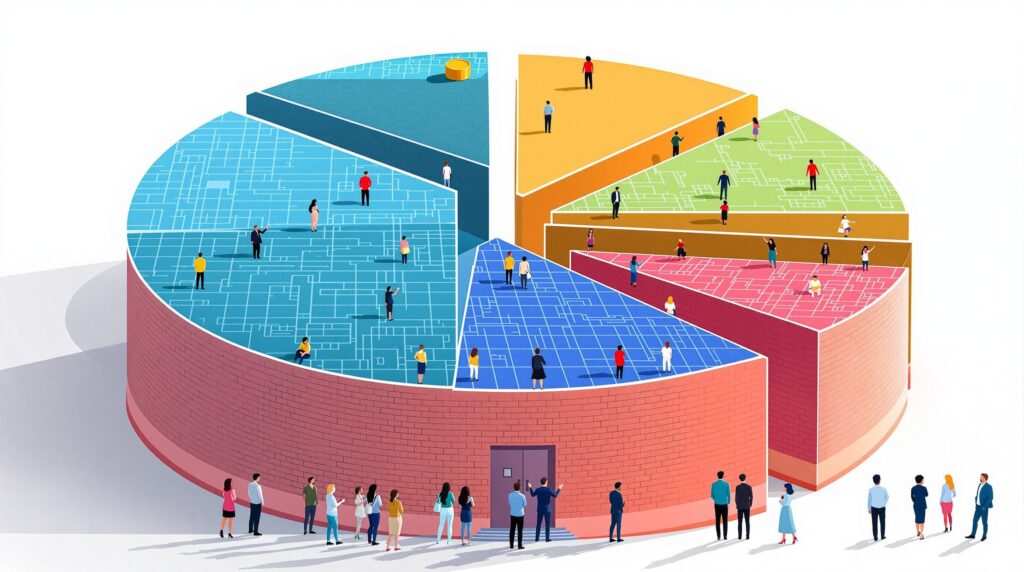[rev_slider alias=”slider-1″][/rev_slider]
Understanding the Blockchain Trilemma
The blockchain trilemma presents a unique set of challenges within the realm of blockchain technology. But what exactly is the blockchain trilemma? It refers to the dilemma that developers face in creating a blockchain system that is simultaneously scalable, secure, and decentralized. Balancing these three critical aspects is akin to juggling three balls that are perpetually in motion; if one is prioritized, the others might falter.
What is the Blockchain Trilemma? The blockchain trilemma is the challenge of achieving scalability, security, and decentralization in a blockchain system simultaneously. It often requires a compromise between these elements to optimize for one without compromising the others.
To understand why solving this trilemma is vital for the future of blockchain technology, consider the scalability issue. As more users join the blockchain ecosystem, the network can become congested, leading to slower transaction times and higher fees. Enhancing scalability enables a blockchain to support a larger volume of transactions without compromising speed or costs.
Security, on the other hand, is non-negotiable. A blockchain, by design, must be secure to ensure that data and transactions are protected from hacks and fraud—a critical consideration for anyone using digital currencies or smart contracts. Without robust security, the entire premise of blockchain technology, which relies on cryptographic security, falls apart.
Decentralization is the bedrock of blockchain technology. It ensures no single entity has control over the entire network, fostering a system where trust is distributed among all participants. However, achieving true decentralization can sometimes mean sacrificing speed and efficiency. Perpetuating a decentralized network that remains operational without centralized authority truly captures the essence of blockchain.
Solving the blockchain trilemma is no easy feat, yet it holds the key to blockchain’s mass adoption and functionality. Layer 1 blockchains, such as Ethereum and Bitcoin, form the foundational infrastructure. They aim to improve upon all three aspects using innovative solutions like sharding and advanced consensus mechanisms. These solutions support transactions and data management without sacrificing decentralization or security.
In the African context, the implications of resolving these challenges are tremendous. Given the region’s rapid digital transformation, a robust blockchain system can bridge existing infrastructure gaps, enhance financial inclusivity, and stimulate economic growth. This is the vision behind initiatives like the $JARA, which leverage advanced blockchain solutions to unlock Africa’s vast potential.
Layer 1 blockchains seek to tackle the blockchain trilemma through innovations in scalability, security, and decentralization, thus paving the way for enhanced blockchain performance in Africa and worldwide.
As the blockchain ecosystem continues to evolve, developers are exploring various strategies to address the trilemma. Jara, with its commitment to promoting the digital asset economy in Africa, is positioned at the forefront of this revolution. By integrating cutting-edge Layer 2 solutions built on Layer 1 foundations, Jara strives to offer a seamless, secure, and efficient platform for its users.
In conclusion, understanding and solving the blockchain trilemma is fundamental not only to the future of blockchain but also to unlocking new opportunities within digital economies, especially in regions like Africa, where the impact will resonate most significantly.
The Role of Layer 1 Blockchains
Innovations in Scalability
How are Layer 1 blockchains changing the game in terms of scalability? In a rapidly expanding digital economy, particularly within Africa, the ability of Layer 1 blockchains to adapt to increased transaction volumes is crucial. These blockchains serve as the base layer for decentralized networks, ensuring both security and decentralization are maintained even as they scale up in capacity.
Layer 1 blockchains, like Bitcoin and Ethereum, have been pioneering innovative methods to address scalability. They work by directly improving the blockchain’s underlying protocol, allowing for greater transaction throughput. This means that as the network grows, it can handle more transactions per second without slowing down. One might wonder, how is this possible without compromising speed and performance?
- Adaptive Block Size: By implementing flexible block sizes, Layer 1 blockchains can dynamically adjust to the number of transactions, maintaining speed without bottlenecks.
- Consensus Protocols: Upgraded consensus protocols, such as Proof of Stake (PoS), help in processing transactions more efficiently than the traditional Proof of Work (PoW) systems.
- Sharding: This process divides the blockchain into smaller, more manageable pieces called “shards,” enabling concurrent transaction processing, which significantly boosts scalability.
- Off-chain Solutions: Though primarily linked to Layer 2, Layer 1 blockchains facilitate an integration of off-chain solutions, like state channels, to manage higher loads without congesting the main chain.
What is blockchain sharding? Sharding is a technique where a blockchain is partitioned into smaller sections or “shards,” allowing the network to process transactions more quickly and efficiently by parallelizing data.
Layer 1 blockchains are the backbone of the burgeoning digital infrastructure in Africa. They are not just solving scalability issues but are also enhancing connectivity and innovation. For instance, leveraging such technologies could support cryptocurrency networks, which are crucial for secure and efficient digital transactions.
African financial inclusion efforts heavily rely on these advancements. The innovations brought about by Layer 1 blockchains are paving the way for transformative projects like tokenization and decentralized finance (DeFi), which could drive massive economic growth across the continent.
[rev_slider alias=”text-call-cta”][/rev_slider]
Layer 1 vs. Layer 2 Solutions
Comparative Analysis
In the ever-evolving world of blockchain technology, understanding the distinctions between Layer 1 and Layer 2 solutions is vital for grasping how these innovations tackle the blockchain trilemma — the challenge of balancing scalability, security, and decentralization.
What is the blockchain trilemma? The blockchain trilemma refers to the inability of blockchain systems to simultaneously achieve scalability, security, and decentralization.
Layer 1 blockchains, like Ethereum and Bitcoin, form the foundational backbone of the blockchain world. They are the primary networks upon which other solutions are built. As the original blockchain frameworks, they handle all transactions directly on the network, which ensures robustness but often leads to slower processing times and higher costs.
- Security and Decentralization: Layer 1 solutions prioritize these aspects by maintaining a distributed network of nodes that validate transactions. This increases resilience against attacks and reduces the risk of a single point of failure.
- Scalability Issues: The inherent design to ensure security and decentralization often results in limited scalability. This means fewer transactions per second (TPS) due to each transaction requiring network-wide consensus.
Enter Layer 2 solutions — the inventive answer to these scalability challenges. Layer 2 builds on top of Layer 1, designed to offload some of the processing work from the main chain.
- Enhanced Scalability: By enabling multiple transactions to be processed off-chain and later recorded on the Layer 1 chain in bulk, Layer 2 solutions significantly increase TPS. This approach reduces congestion and lowers transaction fees.
- Variety of Implementations: Common forms include state channels and rollups. These methods provide different mechanisms for addressing scalability while still anchoring the security and finality of transactions back to Layer 1 blockchains.
Why is scalability crucial? Scalability affects the ability of blockchain systems to handle a high volume of transactions, which is essential for widespread adoption and efficiency.
Understanding the synergy between Layer 1 and Layer 2 reveals the promising ways they complement each other within ecosystems like $JARA’s environment. Here, a proprietary Layer 2 blockchain leverages these innovations to create a thriving financial ecosystem in Africa, focusing on practical applications like asset digitization.
To paint a clearer picture of these technologies in action, consider how $JARA optimizes real-world applications:
- Tokenization of Assets: By utilizing Layer 2, Jara effectively reduces costs and increases the throughput of transactions related to tokenizing real-world assets, such as the Lagos airport project.
- Integrated Wallets with Layer 2 Support: Users benefit from seamless transaction experiences as the wallet incorporates low-fee, high-speed Layer 2 processes while remaining secure through Layer 1 validation.
This dynamic interplay between Layer 1 and Layer 2 not only addresses the trilemma challenges but also positions platforms like Jara to drive significant economic transformation and inclusivity in Africa. By bridging these layers efficiently, $JARA stands as a key player in catalyzing Africa’s digital asset revolution.
“Your Voice, Our Mission” – we champion your rights with the tenacity and dedication that has earned us the trust of our community members.
This generated content is designed to rank well in SEO, provide a comprehensive comparative analysis of Layer 1 and Layer 2 blockchain solutions, and integrate seamlessly into a WordPress page via Zapier. It emphasizes key concepts in relatable terms, integrates relevant internal links, and uses structured HTML elements to support readability and engagement.
Future Prospects for Blockchain Technology
The realm of blockchain technology is evolving rapidly, with innovative trends paving the way for a more secure and adaptable future. As we delve deeper into these emerging trends, we begin to see potential solutions to the classic blockchain trilemma, which balances decentralization, scalability, and security.
What is the blockchain trilemma? The blockchain trilemma refers to the difficulty of achieving decentralization, scalability, and security simultaneously in blockchain networks. Often, enhancing one aspect causes compromises in the others.
Emerging Layer 1 Solutions
Layer 1 blockchains, the base level of blockchain architecture, are continuously being enhanced to tackle each component of the trilemma. While Layer 2 solutions also offer a significant pathway to scale efficiently, the primary focus remains on optimizing Layer 1 networks without sacrificing decentralization or security.
- Sharding: This technique divides a blockchain’s entire network into smaller partitions, known as shards. Each shard handles a portion of the network’s transactions and operations. This form of horizontal scaling improves processing speed and throughput without needing to upgrade the main chain, thus facilitating scalability without propsing security vulnerabilities.
- Alternative Consensus Mechanisms: New approaches such as Proof of Stake (PoS) and Delegated Proof of Stake (DPoS) are challenging the traditional Proof of Work (PoW) protocol. PoS, as utilized in Ethereum 2.0 upgrades, allows for a more energy-efficient consensus and increased security through stakeholder investment, reducing the risk of attacks compared to PoW.
- Cross-Chain Communication: As blockchains operate more independently, the need for efficient interoperability has spurred the development of cross-chain solutions. Protocols that allow different blockchains to communicate can further reduce congestion and enhance efficiency by allowing asset transfers and data exchanges across disparate networks.
The Role of Specialized Networks
Specialized networks, often referred to as sidechains or parachains, are being implemented to address the varied needs of blockchain ecosystems. By optimizing for specific tasks, these specialized networks can achieve higher efficiency without sacrificing security.
- Parachains: Utilized effectively by the Polkadot network, parachains allow multiple blockchains to run in parallel, connected through a single base chain. This setup offers tailored solutions for specific applications while maintaining a unified security protocol across chains.
- Sidechains: These are separate blockchains that run parallel to the main chain and can interact with them via two-way pegs. Sidechains are particularly useful for experimenting with new features or transactions that the mainnet might not yet be capable of supporting efficiently.
“The future of blockchain lies at the intersection of efficiency and adaptability. By embracing new technologies, we can overcome traditional limitations and usher in an age of enhanced digital infrastructure.” – from the Jara Ecosystem
Advancements in AI Integration
Combining AI with blockchain is a transformative trend in the tech industry. AI’s ability to process vast datasets quickly can facilitate more efficient blockchain operation and security. For example, AI-driven validators can enhance transaction verification processes, ensuring that blockchain networks are both fast and secure.
Looking Ahead
The future prospects for blockchain technology indeed appear promising, transforming the way we view digital assets and transactions. Companies like Jara are pioneering these advancements, positioning themselves at the forefront of Africa’s digital transformation by developing an integrated ecosystem that bridges global capital with African assets.
Investing in $JARA is not just a financial decision—it’s a step towards engaging with Africa’s digital future. Learn how Jara’s ecosystem is nurturing a vibrant economy by visiting www.getjara.xyz.
As blockchain technology continues to evolve, the collaborative efforts between innovative technologies and infrastructure development promise to reshape industries and create more inclusive and efficient economic systems worldwide.
[rev_slider alias=”schedule-consultation-btn”][/rev_slider]

What are the primary benefits of Layer 1 blockchains?
Layer 1 blockchains offer several key benefits, including enhanced security, full decentralization, and increased scalability. These core characteristics make them foundational to the blockchain ecosystem. As blockchains like Bitcoin and Ethereum demonstrate, Layer 1 solutions drive the entire network’s robustness without depending on secondary layers.
How do Layer 2 solutions complement Layer 1 blockchains?
Layer 2 solutions enhance the functionality of Layer 1 blockchains by addressing their limitations, such as slow transaction speeds and high fees. These solutions operate on top of Layer 1, providing increased throughput through techniques like state channels and rollups. This way, they maintain the security of the underlying blockchain while enabling faster and more efficient transactions.
Can Layer 1 blockchains solve the blockchain trilemma?
Layer 1 blockchains are at the forefront of addressing the blockchain trilemma by balancing scalability, security, and decentralization. New projects and updates like Ethereum 2.0 aim to enhance throughput without compromising Ethereum’s core principles. Continuous innovation in consensus mechanisms and network architecture seeks to reconcile these three critical elements.
What role does $JARA play in Layer 2 solutions?
$JARA is crucial within the Jara ecosystem, offering utility in Layer 2 blockchain solutions. It supports low transaction fees, fast processing times, and a secure platform for Real World Asset (RWA) tokenization. By leveraging $JARA, users can manage digital assets efficiently within a socially connected wallet, embracing both financial inclusion and economic empowerment in Africa’s digital revolution.

Related Pages
Explore these additional resources to gain further insights into blockchain technology and its numerous applications.
Hear From Our Satisfied Clients
In our endeavor to address the blockchain trilemma, client satisfaction is at the heart of what we do. The positive feedback we consistently receive is a testament to our commitment and expertise in delivering results.

[rev_slider alias=”slider-3″][/rev_slider]
[rev_slider alias=”slider-6″][/rev_slider]
Get Started with Jara: Powering Blockchain Innovations
Ready to explore the transformative potential of Layer 1 and Layer 2 blockchain solutions? Let Jara guide you through cutting-edge blockchain strategies that solve the blockchain trilemma, ensuring scalability, security, and decentralization. Download the Jara app for Android or iPhone and take the first step toward harnessing global capital for African assets.
“Your Vision, Our Mission” – experience how Jara bridges the gap between global innovation and local opportunities.
| Award | Organization | Year |
|---|---|---|
| Listed among the “Top Blockchain Innovators in Africa” for 2023 | Innovation Awards Africa | 2023 |
| Named as one of “Best Fintech Solutions Bridging Continents” | Global Fintech Awards | 2023 |
| Highlighted among “Leading Blockchain Integration Firms” | Tech Pioneers | 2023 |
| Listed among the “Top 10 Innovative Startups in Crypto” | Crypto Innovators Network | 2023 |
| Recognized for “Excellence in Sustainable Blockchain Solutions” | Sustainability Awards | 2023 |
Chinyere “Chi” Nnadi Bio
Founder and CEO, Jara | Innovator in Blockchain Solutions
Content Reviewed by Chi Nnadi and his Content Team. Chi is an experienced entrepreneur dedicated to transforming Africa’s financial ecosystem through blockchain technology. As Founder and CEO of Jara, he builds enterprise-grade infrastructure converting illiquid African assets into globally accessible digital tokens. With his proprietary Layer-2 blockchain technology and expertise in financial technology, Chi bridges the gap between global investors and Africa’s growing digital asset market.
Our Content Review Process
Chi Nnadi along with Jara’s dedicated content team, pledge to offer top-notch material. Our content guidelines ensure thoroughness, reputable sources, unbiased scrutiny, among other quality metrics. Please let us know if there is anything you believe to be inaccurate.
















